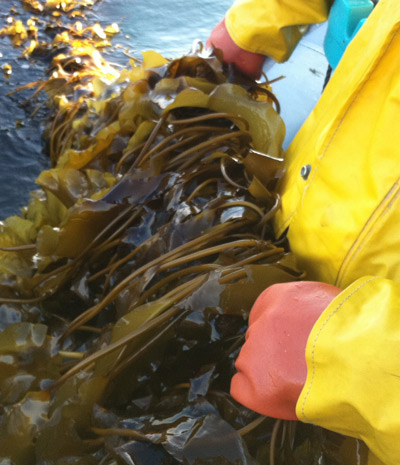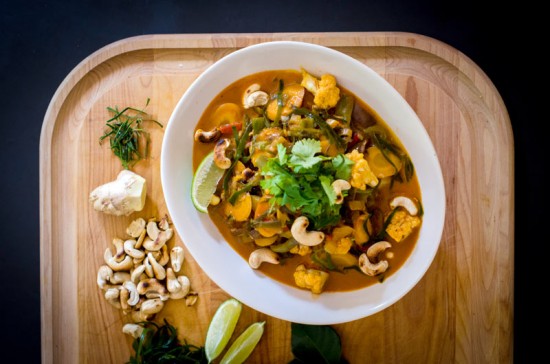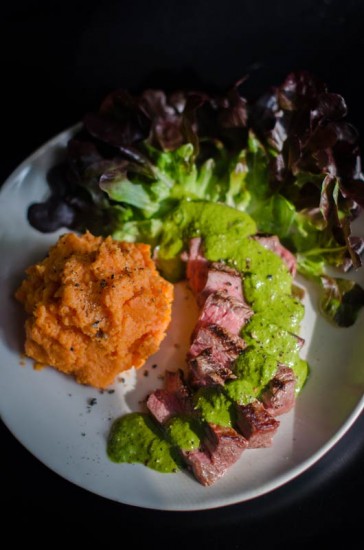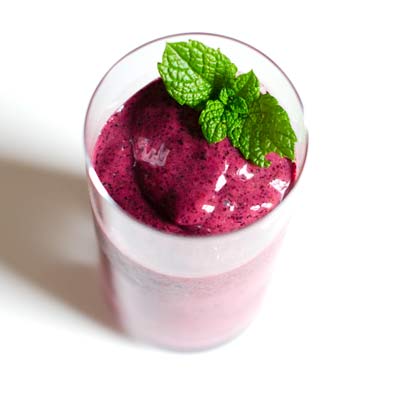I have to share with you how much I love eating kelp. You can buy it in the dehydrated form in many health food stores, but recently I got to try some raw kelp in a slaw and it was so much better. Kelp has been a staple for thousands of years in the northeast, Europe and Asia, but our modern appetites forgot its flavor. As our food culture shifts toward sustainability, improved nutrition, kelp is ready to make a scene. Not only does it taste great, but it’s really important to incorporate into your diet. When we switch to a paleo diet, we ditch our industrially processed foods with added salt, and swap out fortified table salt in exchange for all natural sea salt. Although you are getting tons of great minerals from sea salt, one thing you may be missing is iodine. Kelp is a rich source of iodine, but it’s important where you get your kelp from.
I spoke with the folks who run Ocean Approved, a kelp company in Maine. “When we first started the company, we wild-harvested 100% of our kelp. However, pulling it from the wild is not sustainable. Kelp provides critical habitat for many species. Having seen the changes to the ocean in our lifetime, and having been part of failed fisheries when we were younger, we are committed to leaving a better legacy for our children. Bear with my humor, but will you kelp us kelp the earth?” asked Tollef Olson, founder of Ocean Approved.
Earning marks as the first kelp farmers in the United States, Olson and his crew of rubber aproned Mainers lease open ocean plots from the state, growing their kelp in the clear cold waters of the Gulf of Maine. The kelp is seeded on 1,500 foot lines that are suspended 7 feet below the surface and about 20 feet above the sea bed, so the floating farm never disturbs the ocean floor. Ocean Approved is seeding their farms now for harvest in the late winter and spring. Come March, the kelp will grow about 5 ½ inches each day.
Thanks to kelp’s incredible growth rate, Ocean Approved produces up to 33,000 pounds of highly nutritious foods per acre each season. “Our farming operations are able to create all this food without using any arable land, fresh water, fertilizers or pesticides,” said Frances Buerkens, Ocean Approved’s operations manager. “I’m new to the seaweed scene, but having studied commercial agriculture’s detrimental impact on soil and water, I was determined to work for a company that promotes private sector solutions to global environmental concerns.”
Our oceans have an excess of nitrogen, phosphorus, and CO2, primarily due to large-scale agricultural activities. Kelp absorbs these excess nutrients and releases oxygen, helping to re-balance the water chemistry of our coastal waters.
Depending on where kelp is grown, its proclivity for bioaccumulation can be great for our health – but it can also be risky. It’s important to understand where your kelp is grown and whether it’s farmed or wild harvested. Like any food that you eat, sourcing transparency is critical. Know your farmer!
Most kelp is imported from China, Korea, and Japan, dredging up questions about its pedigree. Was it grown in clean waters? How was it processed? Both are important questions. Fortunately there’s a domestic alternative to imported kelp. Ocean Approved tests their kelp for heavy metals and radiation. No detectable amounts have ever been identified.
Food safety doesn’t stop at knowing your famer: We need transparency with food processors as well. Looking at the other kelp products on the market Ocean Approved realized that many of these products contain preservatives, as well as blue dye #1 and yellow dye #5 to maintain a green color. Knowing their customers would want a 100% natural product, they came up with a healthier alternative.
Nature designed Maine kelp to freeze twice a day in the winter. The ebb of Maine’s 15+ foot tides exposes this resilient species to freezing temperatures. Taking a queue from nature, Ocean Approved blanches and freezes the kelp, resulting in a 100% natural, fresh frozen product that is mild in flavor, vibrant in color, and easy to use.
Kelp in Your Kitchen
Ms. Buerkens, a veritable cooking addict is astonished at how eagerly her steak-and-salad family has integrated kelp into their diet. “At first I thought they would think it’s too weird, but now they ask for it. Today, I’m working on the perfect green smoothie recipe so we can have a healthy kelp breakfast on the go.”
Fresh, frozen kelp is mild in flavor and lacks the salty and fishy flavors that overpower dried kelp. Whether you’re making a bacon omelet or a grain-free chocolate cake, kelp integrates seamlessly, complimenting rather than dominating other ingredients.
The health benefits of kelp are legendary. Kelp contains more calcium than milk, more iron than spinach – and it’s loaded with fiber and iodine. Providing more minerals to your body than most green vegetables, kelp is the perfect complement to a high protein and high fat diet. As we seek alternatives to gluten-laden ingredients and embrace a low carb diet, Ocean Approved kelp is ready to make a scene.
You may purchase fresh, frozen kelp at oceanapproved.com.
Special 10% discount on the Paleo Pack: #KELPCLAN
Want some recipes using kelp? How about Thai Red Curry:
Grilled Sirloin Steak with Italian Salsa Verde





Hey Robb – thanks for the referral & coupon code. What is your guy’s opinion on kelp supplements as a means to acquire otherwise hard to get iodine? Also, is kelp supplementation (or just eating it) enough to normalize slight hypothyroidism? my TSH was on the high end of normal on my labs, enough to raise my doc’s eyebrows and mention the possibility of going on Thyroid hormones. But, I’d rather “fix” it naturally if I can. Any advice on this topic is greatly appreciated.
Kelp supplementation or consumption can be a good source of iodine.
As for slight hypothyroidism, that would really depend on the cause of it. I would suggest working with a good functional medicine doctor or someone who really knows thyroid stuff.
I love this. My mom used to use kelp and anchovy to make stock for soup all the time. It’s pretty common in Korean cooking and it’s delicious. I totally forgot about it until I saw this post. Definitely need to bring it back in my life!
A great article.
I am also passionate about seaweed, I started with Japanese food and continue with hundreds of international recipes and since then I’ve learned to love them.
They are a great resource that should not be neglected.
Regards.
I don’t find a full nutritional label on the website, just an iodine analysis. Anybody know the serving size and number of servings per package?
Another product that is not shipped to Canada. Sigh.